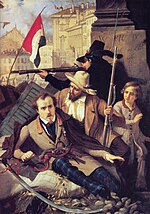Carbonari
 Masonic emblem of the Carboneria | |
 Carbonari triband | |
| Formation | Early 19th century |
|---|---|
| Type | Conspiratorial organisation |
| Purpose | Italian unification |
| Location | |
Key people | Gabriele Rossetti Louis-Napoléon Bonaparte Giuseppe Garibaldi Silvio Pellico Aurelio Saffi Antonio Panizzi Giuseppe Mazzini Ciro Menotti Melchiorre Gioia Piero Maroncelli |
TheCarbonari(lit. 'charcoal burners') was an informal network ofsecret revolutionary societiesactive in Italy from about 1800 to 1831. The Italian Carbonari may have further influenced other revolutionary groups inFrance,Portugal,Spain,Brazil,Uruguay,theOttoman Empire,andRussia.[1]Although their goals often had apatrioticandliberalbasis, they lacked a clear immediate political agenda.[2]They were a focus for those unhappy with the repressive political situation in Italy following 1815, especially in the south of theItalian Peninsula.[2][3]Members of the Carbonari, and those influenced by them, took part in important events in the process ofItalian unification(called theRisorgimento), especially the failedRevolution of 1820,and in the further development ofItalian nationalism.The chief purpose was to defeat tyranny and establish a constitutional government. In the north of Italy other groups, such as the Adelfia and the Filadelfia, were associate organizations.[2][3]
Organization
[edit]The Carbonari were asecret societydivided into smallcovert cellsscattered across Italy. Although agendas varied, evidence suggests that despite regional variations, most of them agreed upon the creation of a liberal, unified Italy.[4]The Carbonari wereanti-clericalin both their philosophy and programme. The Papal constitutionEcclesiam a Jesu Christoand the encyclicalQui pluribuswere directed against them. The controversial documentAlta Vendita,which called for a liberal or modernist takeover of the Catholic Church, was attributed to theSicilianCarbonari.[5]
History
[edit]Origins
[edit]Although it is not clear where they were established,[6]they first came to prominence in theKingdom of Naplesduring theNapoleonic wars.Although some of the society's documents claimed that it had origins in medieval France,[4]and that its progenitors were under the sponsorship ofFrancis I of Franceduring the sixteenth century, this claim cannot be verified by outside sources. Although a plethora of theories have been advanced as to the origins of the Carbonari,[7]the organization most probably emerged as an offshoot ofFreemasonry,[4]as part of the spread of liberal ideas from theFrench Revolution.They first became influential in the Kingdom of Naples (under the control ofJoachim Murat) and in thePapal States,the most resistant opposition to theRisorgimento.[1]
As a secret society that was often targeted for suppression by conservative governments, the Carbonari operated largely in secret. The nameCarbonariidentified the members as rural "charcoal-burners"; the place where they met was called a "Barack", the members called themselves "good cousins", while people who did not belong to the Carbonari were "Pagani". There were special ceremonies to initiate the members.[1]
The aim of the Carbonari was the creation of a constitutional monarchy or a republic; they wanted also to defend the rights of common people against all forms of absolutism.[8]Carbonari, to achieve their purpose, talked of fomenting armed revolts.
The membership was separated into two classes—apprentice and master. There were two ways to become a master: through serving as an apprentice for at least six months or by already being a Freemason upon entry.[6]Their initiation rituals were structured around the trade of charcoal-selling, suiting their name.
In 1814 the Carbonari wanted to obtain a constitution for theKingdom of the Two Siciliesby force. The Bourbon king,Ferdinand I of the Two Sicilies,was opposed to them. The BonapartistJoachim Murathad wanted to create a united and independent Italy. In 1815 Ferdinand I found his kingdom swarming with them. He found an unhoped-for ally in the secret sect of theCalderari,that had separated from the Carbonari in 1813.[9]Staunchly Catholics and legitimists, the Calderari swore to defend the Church and vowed eternal hatred toFreemasonsand Carbonari.[10]Society in theRegnocomprised nobles, officers of the army, small landlords, government officials, peasants, and priests, with a small urban middle class. Society was dominated by the Papacy.[11]On 15 August 1814, CardinalsErcole ConsalviandBartolomeo Paccaissued an edict forbidding all secret societies, to become members of these secret associations, to attend their meetings, or to furnish a meeting-place for such, under severe penalties.[8]
1820 and 1821 uprisings
[edit]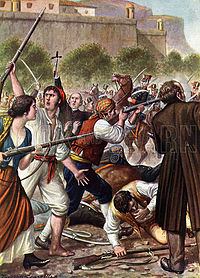
The Carbonari first arose during the resistance to theFrench occupation,notably underJoachim Murat,the BonapartistKing of Naples.However, once the wars ended, they became a nationalist organization with a marked anti-Austriantendency and were instrumental in organizingrevolutionsin Italy in 1820–1821 and 1831.
The 1820 revolution began in Naples against KingFerdinand I.Riots, inspired by events inCádiz,Spain that same year, took place in Naples, bandying anti-absolutist goals and demanding a liberal constitution. On 1 July, two officers, Michele Morelli and Joseph Silvati (who had been part of the army of Murat underGuglielmo Pepe) marched towards the town of Nola in Campania at the head of their regiments of cavalry.
Worried about the protests, King Ferdinand agreed to grant a new constitution and the adoption of a parliament. The victory, albeit partial, illusory, and apparent, caused a lot of hope in the peninsula and local conspirators, led by Santore di Santarosa, marched towardTurin,capital of theKingdom of Sardiniaand 12 March 1821 obtained a constitutional monarchy and liberal reforms as a result of Carbonari actions. However, the Holy Alliance did not tolerate such revolutionary compromises and in February 1821 sent an army that defeated the outnumbered and poorly equipped insurgents in the south. In Piedmont, KingVittorio Emanuele I,undecided about what to do, abdicated in favour of his brotherCharles Felix of Sardinia;but Charles Felix, more resolute, invited an Austrian military intervention. On 8 April, the Habsburg army defeated the rebels, and the uprisings of 1820–1821, triggered almost entirely by the Carbonari, ended up collapsing.[12]
On 13 September 1821,Pope Pius VIIwith the bullEcclesiam a Jesu Christocondemned the Carbonari as aFreemason secret society,excommunicating its members.[13]
Among the principal leaders of the Carbonari, Morelli and Silvati were sentenced to death;Pepewent into exile;Federico Confalonieri,Silvio Pellicoand Piero Maroncelli were imprisoned.
1831 uprisings
[edit]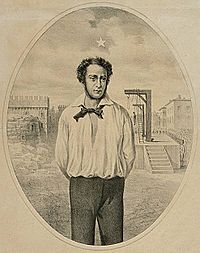
The Carbonari were beaten but not defeated; they took part in therevolution of July 1830[8]that supported the liberal policy of KingLouis Philippeof France on the wings of victory for the uprising in Paris. The Italian Carbonari took up arms against some states in central and northern Italy, particularly the Papal States and Modena.[14]
Ciro Menotti was to take the reins of the initiative, trying to find the support of Duke Francis IV of Modena, who pretended to respond positively in return for granting the title of King of Italy, but the Duke made the double play and Menotti, virtually unarmed, was arrested the day before the date fixed for the uprising. Francis IV, at the suggestion of the Austrian statesmanKlemens von Metternich,had condemned him to death, along with many others among Menotti's allies. This was the last major effort by the secret group.[15]
Aftermath
[edit]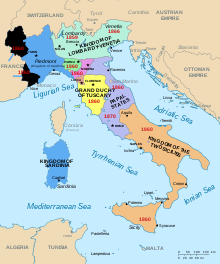
In 1820, the Neapolitan Carbonari once more took up arms, to wring a constitution from King Ferdinand I. They advanced against the capital fromNolaunder a military officer and Abbot Minichini. They were joined byGeneral Pepeand many officers and government officials, and the king took an oath to observe the Spanish constitution in Naples. The movement spread to Piedmont, and Victor Emmanuel resigned from the throne in favour of his brother Charles Felix. The Carbonari secretly continued their agitation against Austria and the governments in a friendly connection with it. Pope Pius VII issued a general condemnation of the secret society of the Carbonari. The association lost its influence by degrees and was gradually absorbed into the new political organizations that sprang up in Italy; its members became affiliated especially with Mazzini's "Young Italy". From Italy, the organization was carried to France where it appeared as the Charbonnerie, which, was divided into verses. Members were especially numerous in Paris. The chief aim of the association in France also was political, namely, to obtain a constitution in which the conception of the sovereignty of the people could find expression. From Paris, the movement spread rapidly through the country, and it was the cause of several mutinies among the troops; it lost its importance after several conspirators were executed, especially as quarrels broke out among the leaders. The Charbonnerie took part in the Revolution of 1830; after the fall of the Bourbons, its influence rapidly declined. After this, aCharbonnerie démocratiquewas formed among the French Republicans; after 1841, nothing more was heard of it. Carbonari was also to be found in Spain, but their numbers and importance were more limited than in the other Romance countries.[8]
In 1830, Carbonari took part in theJuly Revolutionin France. This gave them hope that a successful revolution might be staged in Italy. A bid inModenawas an outright failure, but in February 1831, several cities in thePapal Statesrose and flew the Carbonari tricolour. A volunteer force marched on Rome but was destroyed by Austrian troops who had intervened at the request ofPope Gregory XVI.After the failed uprisings of 1831, the governments of the various Italian states cracked down on the Carbonari, who now virtually ceased to exist. The more astute members realized they could never take on the Austrian army in open battle and joined a new movement,Giovane Italia('Young Italy') led by the nationalistGiuseppe Mazzini,in which many members would trace their origins and inspiration to the Carbonari. Rapidly declining in influence and members, the Carbonari practically ceased to exist, although the official history of this important company had continued, wearily, until 1848. Independent from French Philadelphians were instead the homonymouscarbonaragroup born in Southern Italy, especially in Puglia and in the Cilento, between 1816 and 1828. In Cilento, in 1828, an insurrection of Philadelphia, who called for therestorationof the Neapolitan Constitution of 1820, was fiercely repressed by the director of the Bourbon police Francesco Saverio Del Carretto, whose violent retaliation included the destruction of the village of Bosco.
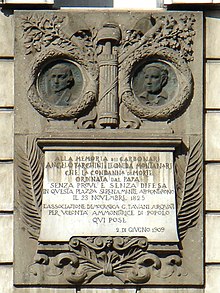
Holy protector
[edit]The members of Carboneria recognizeTheobald of Provinsas thepatron saintof charcoal burners as well as tanners. In fact, for example,Felice Orsini's father, who belonged to Carboneria, wanted to give him the name of Orso Teobaldo Felice.[citation needed]
Prominent members
[edit]
Prominent members of the Carbonari included:
- Gabriele Rossetti
- Amand Bazard
- Silvio Pellico(1788–1854) and Pietro Maroncelli (1795–1846)
- both were imprisoned by the Austrians for years, many of which they spent inSpielberg fortressinBrno,SouthernMoravia.After his release, Pellico wrote the bookLe mie prigioni,describing in detail his ten-year ordeal. Maroncelli lost one leg in prison and was instrumental in translating and editing of Pellico's book in Paris (1833).
- Giuseppe Mazzini
- Marquis de Lafayette(hero of the American and French Revolutions),
- Louis-Napoléon Bonaparte (the future French emperorNapoleon III) Almost certain but highly disputed.
- French revolutionaryLouis Auguste Blanqui.
- Lord Byron
- Giuseppe Garibaldi[citation needed]
Legacy
[edit]In Portugal
[edit]The Portuguese Carbonari (Carbonária) was first founded there in 1822 but was soon disbanded.
A new organization of the same name and claiming to be its continuation was founded in 1896 by Artur Augusto Duarte da Luz de Almeida. This organization was active in efforts to educate the people and was involved in various antimonarchist conspiracies. Most notably,Carbonáriamembers were active in the assassination of KingCharles Iand his heir, PrinceLouis Philipin 1908.Carbonáriamembers also played a part in the5 October 1910 revolutionthat deposed the Constitutional Monarchy and implemented therepublic.[16]One commonality among them was their hostility to the Church and they contributed to the republic'santiclericalism.[17]
Elsewhere in Europe
[edit]Two results of great importance in the progress of the European Revolution (Revolutions of 1848) proceeded from the events that occurred atNaplesin 1820-21. One was the reorganization of the Carbonari, consequent upon the publicity given to their organization when it had brought about the revolution (and the secrecy in which it had hitherto been enveloped was no longer deemed necessary); the other was the extension of the organization beyond theAlps.When the Neapolitan revolution had been effected, the Carbonari emerged from their mystery, published their constitution statutes, and ceased to conceal their program and their cards of membership.[18]
In particular, the dispersion of the Carbonari leaders had, at the same time, the effect of extending their influence in France. GeneralGuglielmo Pepeproceeded to Barcelona when the counter-revolution was imminent at Naples and his life was no longer safe there; and to the same city went several of the Piedmontese revolutionists when the country was Austrianized after the same lawless fashion. The dispersion ofScalviniand Ugoni that took refuge at Geneva and others of the proscribed that proceeded to London added to the progress which Carbonarism was making in France, suggested to General Pepe the idea of an international secret society, which would combine for a common purpose the advanced political reformers of all the European States.[19]
South America
[edit]This sectionmay beconfusing or unclearto readers.In particular, the connection to Carbonari (if any exists) is to be clarified or this section is to be removed from the article.(July 2021) |

Giuseppe Garibaldihas been called the "Hero of the Two Worlds" because of his military enterprises inBrazil,UruguayandEurope.In 1836, Garibaldi took up the cause ofRepublic of Rio Grande do Sulin its attempt to separate from theEmpire of Brazil,joining the rebels known as the Ragamuffins in theRagamuffin War(1835-1845). In 1841, Garibaldi moved toMontevideo,Uruguay.In 1842, he took command of the Uruguayan fleet and raised an "Italian Legion" of soldiers for theUruguayan Civil War(1839-1851). He aligned his forces with a faction composed of the Uruguayan Colorados and the Argentine Unitarios. This faction received support from the French and British Empires in their struggle against the forces of the Uruguayan Government and Argentine Federales.
In literature
[edit]The storyVanina VaninibyStendhalinvolved a hero in the Carbonari and a heroine who became obsessed with this. It was made into a film in 1961.
Robert Louis Stevenson's story "The Pavilion on the Links"features the Carbonari as the villains of the plot.
Katherine Neville's novelThe Firefeatures the Carbonari as part of a plot involving a mystical chess service.
InWilkie Collins' "The Woman in White"the character of Professor Pesca is a member of 'The Brotherhood', an organization placed contemporaneously with, and similarly featured as, the Carbonari. Clyde Hyder suspects that the model for Prof. Pesca wasGabriele Rossetti,who was a member of the Carbonari, as well as an Italian teacher resident in London during the 1840s.
Anton Felix Schindler's biography ofBeethoven"Beethoven, as I Knew Him" states that his close connection with thecomposerbegan in 1815 when the latter requested an account of Schindler's involvement with a riot ofNapoleon's supporters inVienna,who were agitating against the Carbonari uprisings. Schindler was arrested and lost a year at college. Beethoven was sympathetic and, as a result, became a close friend of Schindler.
The Carbonari are mentioned prominently in theSherlock Holmesshort story "The Adventure of the Red Circle"(1911), written bySir Arthur Conan Doyle.
The Carbonari are also mentioned briefly in the book "Resurrection Men"byT. K. Welsh,in which the main character's father is a member of the secret organization.
They feature inTim Powers'The Stress of Her Regardas opponents of the vampire-backed Austrian Empire.
Mr. Settembrini's grandfather inThomas Mann'sThe Magic Mountainis said to be Carbonari.
The Carbonari are mentioned inThe Hundred Daysby Patrick O'Brian, part of the Aubrey-Maturin series.
Umberto Eco'sThe Cemetery of Praguementions the Carbonari, with the main character joining them as a spy.
InThe Horseman on the Roof,the character of Angelo Pardi is a young Italian Carbonaro colonel of hussars
They also appear in Carmen Mola's novelLa Bestia(2021).
Film adaptations
[edit]- Vanina Vanini,byRoberto Rossellini(1961), adaptation of Stendhal's novel of the same name.
- Nell'anno del Signore,byLuigi Magni(1969).
- Allonsanfan,by theTaviani brothers(1973).
- The Horseman on the Roof,byJean-Paul Rappeneau(1995), adaptation of Jean Giono's novel of the same name.
See also
[edit]- Committee of Union and Progress
- Communist League
- Four Sergeants of La Rochelle
- League of the Just
- Secret society
- The Society of Seasons
References
[edit]- ^abcGalt 1994.
- ^abcMack Smith 1988.
- ^abDuggan 2008.
- ^abcRath 1964.
- ^Rambler1854.
- ^abKirsch 1908.
- ^For example, inThe SufisIdries Shahtakes an extensive look at the origins of the Carbonari in a chapter entitled "The Coalmen". He shows a linguistic connection through Arabic to a Sufi group called "The Perceivers" (Shah, Idries (1977) [1964].The Sufis.London, UK: Octagon Press. pp. 178–179.ISBN0-86304-020-9.)
- ^abcdKirsch 1908.
- ^Orloff, Grigorij Vladimirovič.Memoires sur le Royaume de Naples.Vol. II. p. 286.
- ^Dito, Oreste (1905).Massoneria, Carboneria ed altre società segrete.Turin/Rome: Roux-Viarengo. p. 213.
- ^Villari 1911,p. 307
- ^George T. Romani,The Neapolitan revolution of 1820-1821(Northwestern University Press, 1950).
- ^Alan Reinerman, "Metternich and the Papal Condemnation of the" Carbonari ", 1821".Catholic Historical Review54#1 (1968): 55-69
- ^Cornelia Shiver, "The Carbonari".Social Science(1964): 234-241.
- ^Robert Justin Goldstein (2013).Political Repression in 19th Century Europe.Routledge. p. 149.ISBN9781135026691.
- ^McCullagh 1910,p.[page needed].
- ^Birmingham 2003.
- ^Frost 2003,p.1.
- ^Frost 2003,p.2.
Further reading
[edit]- "The Carbonari".The London Literary Gazette, and Journal of Belles Lettres, Arts, Sciences, etc.139:602–3. 18 September 1819.
- Birmingham, David (2003),A Concise History of Portugal,Cambridge:Cambridge University Press,ISBN9780521536868
- Daraul, Arkon (1961), "The Charcoal Burners",A History of Secret Societies,Secaucus NJ: Citadel Press, pp. 100–110,ISBN0-8065-0857-4
- Duggan, Christopher (2008),The Force of Destiny
- Frost, Thomas (2003),Secret Societies of the European Revolution,Kessinger Publishing,ISBN978-0-7661-5390-5
- Galt, Anthony (December 1994), "The Good Cousins' Domain of Belonging: Tropes in Southern Italian Secret Society Symbol and Ritual, 1810-1821",Man,New Series,vol. 29, Wiley, Royal Anthropological Institute of Great Britain and Ireland, pp. 785–807,doi:10.2307/3033969,JSTOR3033969
- McCullagh, Francis (1910),"Some Causes of the Portuguese Revolution",The Nineteenth Century and After,vol. LXVIII
- Rath, John (January 1964), "The Carbonari: Their Origins, Initiation Rites, and Aims",The American Historical Review,69(2): 353–370,doi:10.2307/1844987,JSTOR1844987
- "The Life of a Conspirator",The Rambler,New Series,I,May 1854
- Reinerman, Alan. "Metternich and the Papal Condemnation of the" Carbonari "(1821).Catholic Historical Review54#1 (1968): 55-69.in JSTOR
- Shiver, Cornelia. "The Carbonari".Social Science(1964): 234-241.in JSTOR
- Mack Smith, Denis (1988) [1958],The Making of Italy
- Spitzer, Alan Barrie.Old hatreds and young hopes: the French Carbonari against the Bourbon Restoration(Harvard University Press, 1971).
Attribution:
- This article incorporates text from a publication now in thepublic domain:Villari, Luigi (1911), "Carbonari",inChisholm, Hugh(ed.),Encyclopædia Britannica,vol. 5 (11th ed.), Cambridge University Press, p. 307
 This article incorporates text from a publication now in thepublic domain:Kirsch, Johann Peter (1908), "Carbonari",in Herbermann, Charles (ed.),Catholic Encyclopedia,vol. 3, New York: Robert Appleton Company
This article incorporates text from a publication now in thepublic domain:Kirsch, Johann Peter (1908), "Carbonari",in Herbermann, Charles (ed.),Catholic Encyclopedia,vol. 3, New York: Robert Appleton Company
External links
[edit]- .Encyclopædia Britannica.Vol. 5 (9th ed.). 1878. pp. 88–89.

